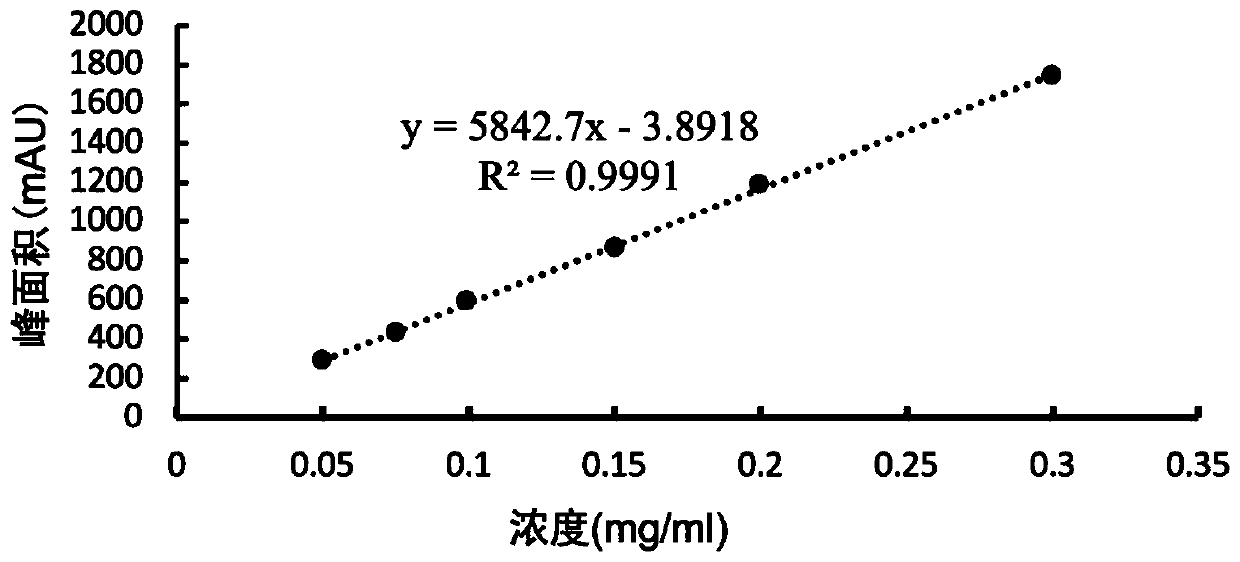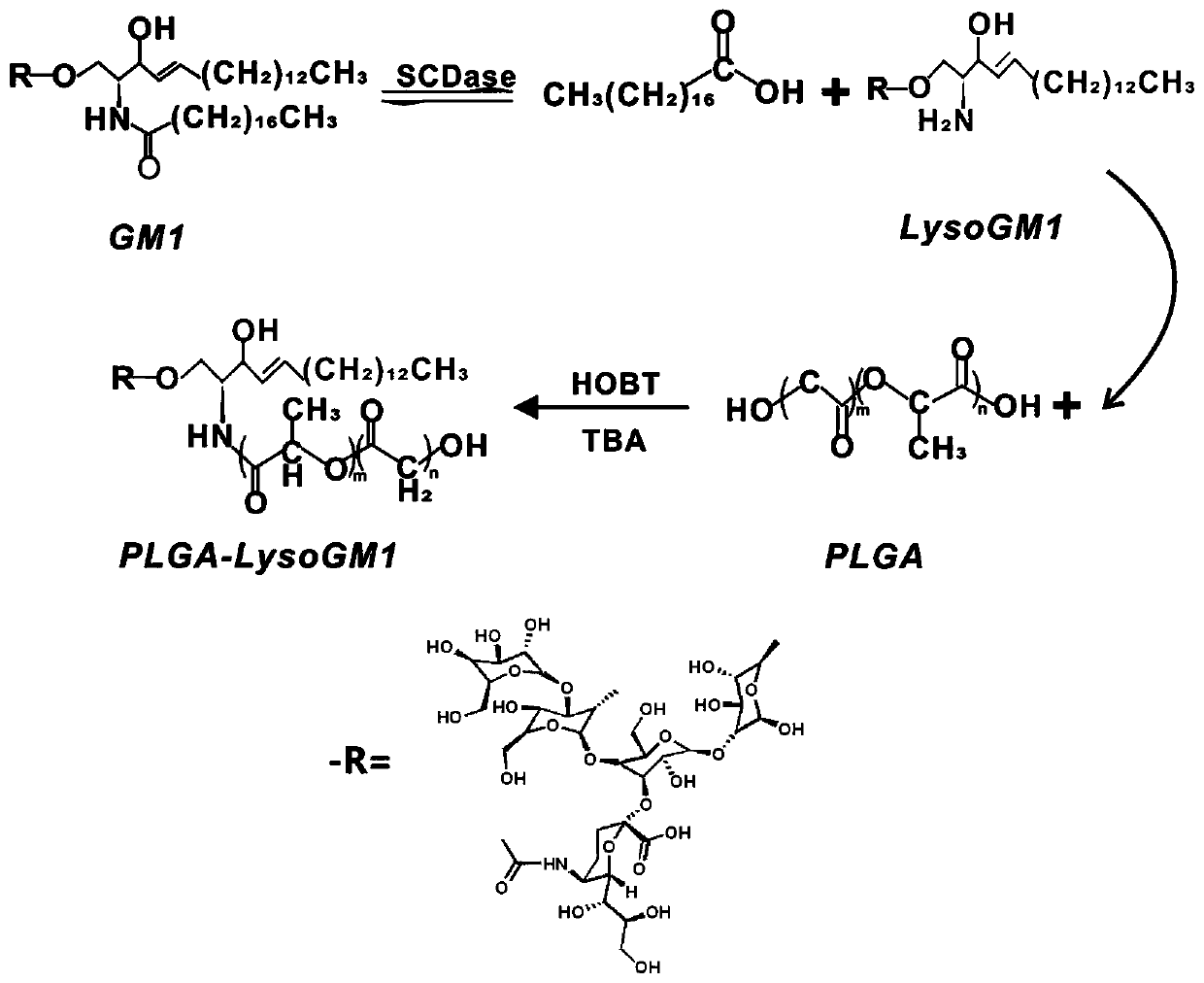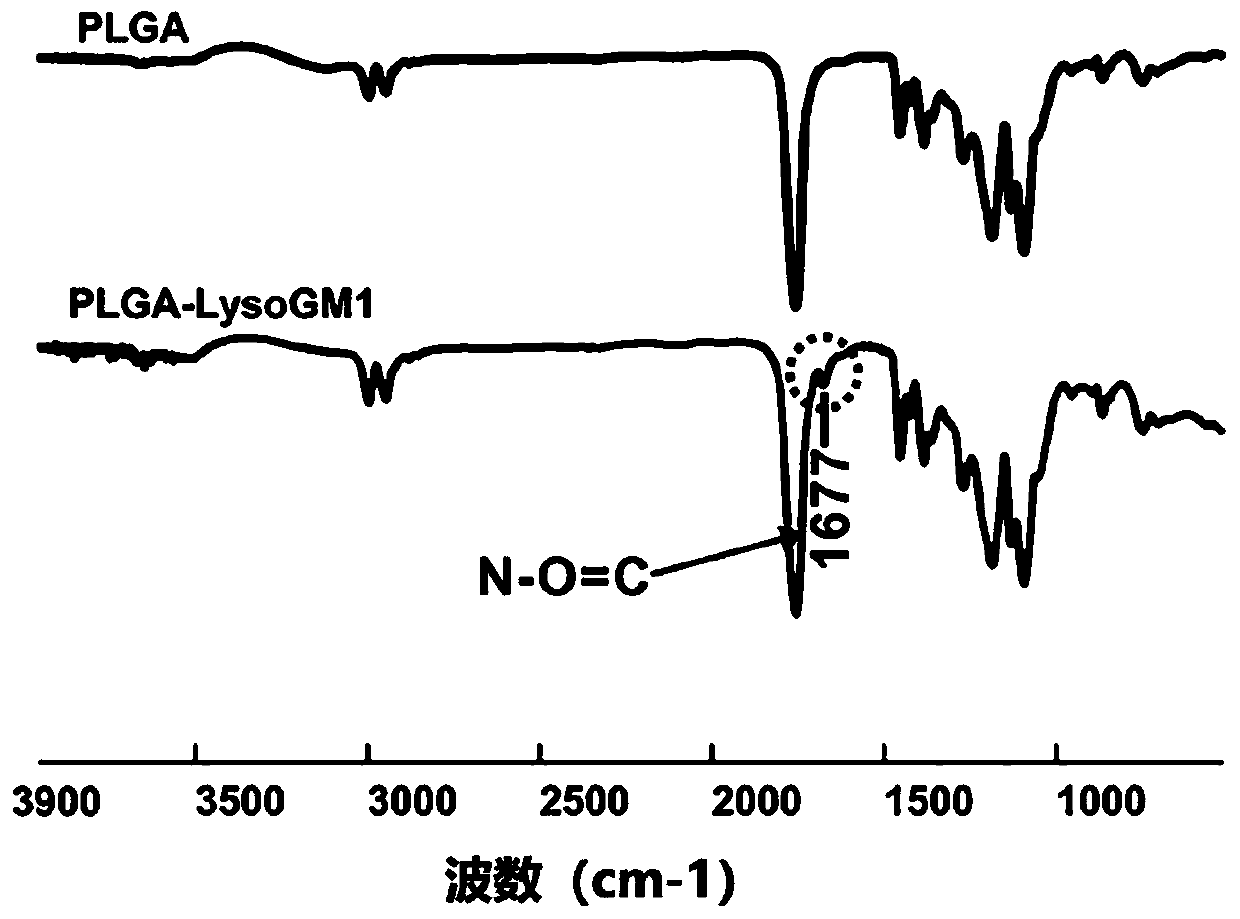Polymer material with nerve tissue repair activity, and preparing method and application of polymer material
A technology of polymer materials and nerve tissue, applied in the field of nerve repair, can solve the problems of increasing adverse reactions and side effects of patients, fluctuations in blood drug concentration, complex stent systems, etc., and achieves good biocompatibility, which is beneficial to later clinical application and storage The effect of stability and the simplicity of the bracket system
- Summary
- Abstract
- Description
- Claims
- Application Information
AI Technical Summary
Problems solved by technology
Method used
Image
Examples
Embodiment 1
[0070] In this example, a hydrolyzate of monosialotetrahexosyl ganglioside (GM1) (expressed as LysoGM1) was prepared and its hydrolysis efficiency was determined. The preparation method is as follows:
[0071] (1) Weigh 0.08g of taurodeoxycholic acid hydrate (TDC), calcium chloride (CaCl 2 ) 10.1g in 20mL of 35mM sodium acetate buffer solution (pH adjusted to 5.8);
[0072] (2) Weigh 100mg of GM1 and add it to the above buffer solution, fully stir to dissolve;
[0073] (3) Transfer to a 50 mL centrifuge tube after fully dissolving, add 15 μL of glycosphingolipid N-deacylase (concentration: 5 U / mL), and place in a constant temperature (37°C) shaking box for shaking reaction for 12 hours;
[0074] (4) Centrifuge at 12000r / min for 5min, take the supernatant and freeze-dry it for storage.
[0075] The hydrolysis efficiency of GM1 is measured by RP-HPLC. The maximum absorption wavelength of GM1 is about 197nm. Since there is more interference below 200nm, 205nm is selected as the...
Embodiment 2
[0079] This example prepares a polymer material with nerve tissue repair activity, which is represented by PLGA-LysoGM1 (the schematic diagram of the synthesis process is shown in figure 2 shown), and analyzed by IR spectroscopy and NMR. Its preparation method is as follows:
[0080] (1) Take by weighing 50 mg of the hydrolyzate LysoGM1 prepared in Example 1, transfer to 10 mL of anhydrous DMF for dissolving, then weigh 1 g of PLGA solid (the number average molecular weight is 8 kDa, the mole of lactic acid structural unit and glycolic acid structural unit Ratio is 75:25), after adding, stir fully to make it dissolve completely;
[0081] (2) Weigh 10.6 mg (hydroxybenzotriazole) HOBt into the above system, add 15.3 μL tributylamine solution, and stir vigorously at room temperature for 2 hours. The molar ratio of LysoGM1 to HOBt, tributylamine, and PLGA is about 1:1.8:1.5:0.3;
[0082] (3) Slowly add the reaction solution dropwise into pre-cooled distilled water (at a temper...
Embodiment 3
[0087] In this example, an engineering scaffold with nerve tissue repairing activity was prepared and observed with a scanning electron microscope. Its preparation method is as follows:
[0088] (1) Said that 500mg of PLGA-LysoGM1 prepared in Example 2 was dissolved in the mixed solution of chloroform:DMF (85:15 mass ratio), and the concentration was 15wt%. Stir at 25°C for 24 hours to make it a uniform solution, and use an ultrasonic oscillator to remove bubbles in the solution;
[0089] (2) Draw the spinning solution into the syringe and place it on the microsampler. Connect the high-voltage DC power supply to the needle of the syringe. The needle type of the syringe is 22G and the inner diameter is 0.41mm. Evenly cover the surface of the circular drum receiver (diameter 15cm) with tinfoil, and ground the drum receiver;
[0090] (3) The set voltage is 15kV, the flow rate of the injector is 1mL / h, the rotating drum receiver is received (rotating speed is 0r / min), and the te...
PUM
| Property | Measurement | Unit |
|---|---|---|
| number average molecular weight | aaaaa | aaaaa |
| diameter | aaaaa | aaaaa |
| number average molecular weight | aaaaa | aaaaa |
Abstract
Description
Claims
Application Information
 Login to View More
Login to View More - R&D
- Intellectual Property
- Life Sciences
- Materials
- Tech Scout
- Unparalleled Data Quality
- Higher Quality Content
- 60% Fewer Hallucinations
Browse by: Latest US Patents, China's latest patents, Technical Efficacy Thesaurus, Application Domain, Technology Topic, Popular Technical Reports.
© 2025 PatSnap. All rights reserved.Legal|Privacy policy|Modern Slavery Act Transparency Statement|Sitemap|About US| Contact US: help@patsnap.com



